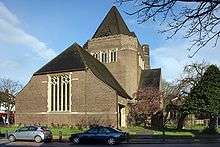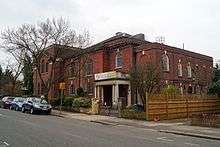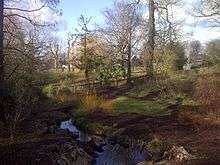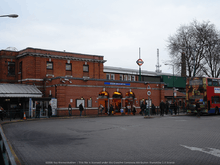Golders Green
| Golders Green | |
 Golders Green clock tower |
|
 Golders Green |
|
| Population | 18,818 (2011 Census.Ward)[1] |
|---|---|
| OS grid reference | TQ248876 |
| London borough | Barnet |
| Ceremonial county | Greater London |
| Region | London |
| Country | England |
| Sovereign state | United Kingdom |
| Post town | LONDON |
| Postcode district | NW11, NW2 |
| Dialling code | 020 |
| Police | Metropolitan |
| Fire | London |
| Ambulance | London |
| EU Parliament | London |
| UK Parliament | Finchley & Golders Green |
| Hendon | |
| London Assembly | Barnet and Camden |
Coordinates: 51°34′24″N 0°11′54″W / 51.5734°N 0.1982°W
Golders Green is an area in the London Borough of Barnet in England. Although the settlement history goes back to the 18th century, Golders Green is essentially a late 19th-century suburban development. It is situated approximately 5.5 miles (8.5 km) north west of Charing Cross and centred on the intersection of Golders Green Road and Finchley Road.
It was historically part of Middlesex, and formed part of the Municipal Borough of Hendon until 1965. In the early 20th century it grew rapidly in response to the opening of a tube station of the London Underground, adjacent to the Golders Green Hippodrome which was home to the BBC Concert Orchestra for many years. The area has a wide variety of housing and a busy main shopping street, Golders Green Road.
It is known for its large Jewish population as well as for being home to the largest Jewish kosher hub in the United Kingdom, which attracts many Jewish tourists.
History
The name Golders comes from a family named Godyere who lived in the area, and Green alludes to the manorial waste on which the settlement was built.[2] Golders Green has been a place in the parish and manor of Hendon since around the 13th century. The earliest references to the name of the adjacent district of "Temple Fortune" is on a map (c. 1754). However this name reveals a much earlier history. It is likely that the name refers to the Knights of St John, who had land here (c. 1240). Fortune may be derived from a small settlement (tun) on the route from Hampstead to Hendon. Here a lane from Finchley, called Ducksetters Lane (c. 1475), intersected. It is likely that the settlement was originally the Bleccanham estate (c. 10th century). By the end of the 18th century Temple Fortune Farm was established on the northern side of Farm Close.
The building of Finchley Road (c. 1827) replaced Ducksetters Lane as a route to Finchley, and resulted in the development of a small hamlet. Hendon Park Row (c. 1860s) is of this period, and consisted of around thirty small dwellings built by a George Stevens, which were, with two exceptions, demolished around 1956. A small dame school and prayer house run by Anglican deaconesses existed in the 1890s and 1900s, and developed to become St. Barnabas (1915). Along Finchley Road were a number of villas (c. 1830s), joined by the Royal Oak public house (c. 1850s). By the end of the 19th century there were around 300 people living in the area, which included a laundry and a small hospital for children with skin diseases. The principal industry was brick making.
In 1895 a Jewish cemetery was established adjacent to Hoop Lane, with the first burial in 1897. Golders Green Crematorium was opened in 1902 (although much of it was built after 1905). A significant moment in Temple Fortune's development into a suburban area occurred in 1907, when transport links were vastly improved by the opening of Golders Green tube station.
Although the area had been served by horse-drawn omnibuses (since at least the 1880s) and later motor buses (from 1907), the tram line of 1910, connecting Finchley Church End with Golders Green Station, led to the development of the area west of Finchley Road. The establishment of Hampstead Garden Suburb brought major changes to the area east of Finchley Road. Temple Fortune Farm was demolished and along the front of the road the building of the Arcade and Gateway House (c. 1911) established the Hampstead Garden Suburb's retail district.
Both the Golders Green Hippodrome, former home of the BBC Concert Orchestra, and the police station opened in 1913.[3] The now-demolished Orpheum Theatre (1930) was intended to rival the Hippodrome in Golders Green.
Geography
The area is situated within the Golders Green electoral ward of the Finchley and Golders Green parliamentary constituency, which encompasses parts of the NW11 and NW2 postcode areas within its geographical borders. The remainder of the Golders Green area is covered by the Childs Hill and Garden Suburb electoral wards.[4] The same boundaries are used for the Golders Green, Childs Hill and Garden Suburb wards of the Metropolitan Police Service.[5]
 |
Hendon | Temple Fortune | Hampstead Garden Suburb |  |
| Brent Cross | |
Hampstead Heath | ||
| ||||
| | ||||
| Cricklewood | Childs Hill | Hampstead |
The area is adjacent to the Heath Extensions part of Hampstead Heath.
Demography
Despite Golders Green often being referred to as a Jewish area, the Christian, Muslim and no-stated-religion populations represent the majority of Golders Green residents[6] with significant populations of Polish and Indian origin.
Ethnically, the Golders Green ward was 64% white (43% British, 21% Other, 1% Irish). Indians, Other Asians and Black Africans made up 5% each. 6% claimed 'Any other ethnic group', which is unusually high.[7]
Jewish Community
There has been a prominent Jewish community since the 20th century. The Jewish community took root after Hitler's rise to power, with the first German Jewish immigrants forming the Golders Green Beth Hamedrash. Soon after, Galician Jewish immigrants formed other synagogues. With it came the formation of Jewish schools such as Menorah before the onset of World War II. By the 1950s, the Jewish population tripled. There are close to 50 Kosher restaurants and eateries under rabbinical supervision in Golders Green, and more than 40 synagogues dotted throughout the area continuing into neighbouring Hendon, as well as 30 schools (some in outlying areas due to space restriction), many of them private. The Jewish community of Hendon and Golders Green is viewed as one, sharing the schooling system as well as rabbinical guidance. Jews made up 37% of the population according to the 2011 census, whereas Christians made up 26%.[8]
Japanese & Southeast Asian Community
Golders Green is home to a growing Japanese and Southeast Asian community[9] with many families living in the district[10] being catered for a notable number of restaurants and shops specialising in Japanese and Southeast Asian food.
African Community
In the early 1970s, Africans from Nigeria and a number of Ugandan Asians expelled by the regime of Idi Amin settled in Golders Green.
The annual BEFFTA Awards are often held at the El Shaddai International Christian Centre,[11] with celebrities such as Trevor McDonald presenting awards.[12]
Economy
The area has restaurants with cuisines from all over the world, from Kosher food, through to Indian, Thai, Japanese, Chinese, Korean and Italian eateries. These are over a dozen coffee bars; together with a number of niche food stores, including two Japanese, two Iranian, two Korean and one Malaysian.
Transport
Golders Green station is a London Underground tube station on the Northern line in zone 3. It is the first surface station on the Edgware branch when heading north. On the station's forecourt is Golders Green bus station. This is a major hub for London Buses in North West London.[13] National Express coaches also stop at the bus station before/after central London.
Many bus routes pass through Golders Green, including the 210 to Finsbury Park, the 82 to Victoria and the 102 Edmonton Green, and from Golders Green station the 240 to Edgware, the 183 to Pinner and the 83 to Ealing Hospital begin their routes.
Education
There are six state aided primary schools in Golders Green; these include: Brookland infant & junior, Garden Suburb infant & junior, Menorah primary school and Wessex Gardens.[14] Henrietta Barnett School is located in nearby Hampstead Garden Suburb.
Religious sites


The Carmelite Monastery was established in Bridge Lane in 1908[15] and sold in 2007.[16] The Anglican parish church of St. Alban the Martyr in North End Road was designed by Sir Giles Gilbert Scott, and in 1933 replaced the original eponymous church on the site, which is now the parish hall. The latter was built in 1910 and made a parish church in 1922.[17] St. Edward the Confessor, a Roman Catholic church, was built in 1915 and consecrated in 1931.[18] There is also a Greek Orthodox cathedral on Golders Green Road,[19] and a Coptic Orthodox church,[20] both having been Anglican churches for most of the 20th century.
There are several synagogues in the area. The first in the area, Golders Green Synagogue, started in 1915 and its current building in Dunstan Road opened in 1922.[21][22] The Golders Green Beth Hamedrash opened in Golders Green in 1935, moving to the Riding in 1956. The Sassover Beis Hamedrash Helenslea Avenue moved to Golders Green from the east end in 1938 as well as the Beis Yissochor Dov currently in Highfield Avenue, the most sought after and busiest. The Machzike Hadath Synagogue moved to Golders Green in the 1970s, opening its present building in 1983.[23] In about 1960 the Eastern Jewish Community established the Ohel David Eastern Synagogue at the Lincoln Institute, the former site of the Golders Green Beth Hamedrash.[24] The Synagogue Beth Shmuel opened in 1942 in Oakfields Road and relocated at 169-171 Golders Green Road since 1952[25] and is one of the most prominent synagogues in North West London with Grand Rabbi Elchonon Halpern the longest serving Rabbi since its inauguration in 1942.
The one-time Hindu temple atop Helenslea Avenue, decommissioned in 2013,[26] was previously St Ninian's Presbyterian Church, built in 1911 by T. Phillips Figgis who was also noted for designing some stations on the Northern line. The congregation merged with Golders Green Methodist Church (now Trinity Church, Hodford Road) in 1979. There is a Unitarian chapel built in the Romanesque style on Hoop Lane which contains some interesting murals from the 1920s. The former Hippodrome theatre is now an El Shaddai International Christian Centre.
Community facilities

Golders Hill Park, adjoining the West Heath of Hampstead Heath, is a formal park, which includes a small zoo, a walled horticultural garden, pinetum, duckponds, a water garden and a café. During the summer, children's activities are organised and there is often live music on the bandstand. Close to the park, also adjoining the West Heath is the Hill, a formal garden with an extensive and imposing pergola.
Nearby Golders Green Crematorium has an extensive garden with features such as a special children's section and a pond, in keeping with the distinct Italianate air. It is sometimes referred to as the 'celebrity crematorium' because of the high proportion of nationally and internationally renowned public figures to have been cremated there. Famous people whose cremations have taken place include Kingsley Amis, Marc Bolan (born, Mark Feld), Neville Chamberlain, T. S. Eliot, Sigmund Freud, Hugh Gaitskell, John Inman, Keith Moon, Ivor Novello, Anna Pavlova, Frank Rutter,[27] Peter Sellers, Ghisha Tuckman (born Ghisha Koenig), Amy Winehouse, Michael Foot, Tommy Vance and Wendy Richard.
Appearances in popular culture
The area is the setting of the humorous short story "The Ghoul of Golders Green" (May Fair, 1925) by Michael Arlen.
A 1960s recording "Finchley Central" by the New Vaudeville Band refers to a possible Northern line tube journey: "For Golders Green change at Camden Town", though in reality bus would be far quicker between these two points.
George Harrison recorded an unreleased track called "Going Down to Golders Green". This came about because he would visit members of the pop group Badfinger, who lived at 7 Park Avenue, off North End Road, situated on the borders of Golders Hill Park.
A second posthumous album release of the music of Pete Ham of the pop group Badfinger is titled Golders Green. The first posthumous album release was titled 7 Park Avenue, named after the address of Badfinger's band residence in Golders Green.
In 2009 a mansion in West Heath Avenue was used by TV show The X Factor for the contestants and received significant press coverage.[28]
Dannie Abse, the Welsh-Jewish poet, was once a resident of Golders Green. It provides a backdrop to a couple of his poems such as "Odd" and "3 a.m. in Golders Green Road".
In his travelogue parody "Balham, Gateway to the South", recorded on The Best of Sellers (1958), Peter Sellers parodies John William Burgon's well known description of Petra – "A rose-red city half as old as time" – as "A rose-red city half as gold as green [Golders Green]".
Places of interest
- Golders Green Hippodrome
- Ivy House on North End Road, former home of the renowned Russian ballerina Anna Pavlova
Notable people
- Michael Allmand VC (1923–1944), recipient of the Victoria Cross, was born in Golders Green.
- Helena Bonham Carter, actress, was born in Golders Green.[29]
- Alex Clare, singer-songwriter, lives in Golders Green.
- David Kossoff, actor, lived in Hayes Crescent, near Temple Fortune; his late son, musician Paul Kossoff, grew up there.
- Valerie Grosvenor Myer, writer and academic, and her husband, theatre critic Michael Grosvenor Myer, who had grown up in the district, lived in Hayes Crescent in the early years of their marriage, 1960-63.
- Kathleen Simon, Viscountess Simon, abolitionist, lived and died in Golders Green.[30]
- Osi Umenyiora, former New York Giants defensive end, was born in Golders Green.
- Michael McIntyre, grew up in Golders Green.[31]
- Evelyn Waugh, novelist, author of Brideshead Revisited, lived in Golders Green.
- Ghada Karmi, author, lived in Golders Green with her family after fleeing Palestine in 1948.
The Hon. Victor Masi (Former minister of finance for Nigeria) owned a house in Golders Green. Benjamin Martin was born and grew up in Golders Green.
Notes and references
- ↑ "Barnet Ward population 2011". Neighbourhood Statistics. Office for Nationa Statistics. Retrieved 19 October 2016.
- ↑ Weinreb, Ben (2008). The London Encyclopaedia (3rd ed.). pp. 328–329. ISBN 978-1-4050-4924-5.
- ↑ "The UK's best military driving gifts". wanadoo-members.co.uk.
- ↑ "Finchley and Golders Green BC" (PDF). Boundary Commission for England. 2012. Retrieved 29 January 2013.
- ↑ "Finchley and Golders Green BC". Mayor's Office for Policing and Crime 2014. 2014. Retrieved 29 January 2013.
- ↑ http://www.ukcensusdata.com/golders-green-e05000053
- ↑ http://www.ukcensusdata.com/golders-green-e05000053
- ↑ http://www.ukcensusdata.com/golders-green-e05000053
- ↑ http://hidden-london.com/gazetteer/golders-green/
- ↑ Kosher in the country The Economist 1 June 2006 accessed 14 August 2007
- ↑ http://www.beffta.com/news/?page_id=15
- ↑ http://www.beffta.com/news/?tag=sir-trevor-mcdonald-obe
- ↑ "Buses from Golders Green" (PDF). Transport for London. July 2009. Retrieved 9 October 2009.
- ↑ http://www.barnet.gov.uk/schools-primary.htm?search=true&postcode=NW11
- ↑ "Golders Green, London - Carmelite Nuns". carmelite.org.uk.
- ↑ Kevin Bradford Developers do not rule out demolishing Carmelite monastery, in Golders Green, after winning a High Court ruling against Barnet Council 26 November 2009 Hendon & Finchley Times Retrieved 1 May 2012
- ↑ AIM25 Retrieved 29 November 2013
- ↑ "Roman Catholic Church of St Edward the Confessor". rcdow.org.uk.
- ↑ The Greek Orthodox Cathedral of the Holy Cross & St. Michael Retrieved 1 May 2012
- ↑ St. Mary & Archangel Michael Coptic Orthodox Church Golders Green, U.K. Retrieved 1 May 2012
- ↑ "Golders Green Synagogue". Golders Green Synagogue.
- ↑ "Helen Fry » Golders Green Synagogue: The First 100 Years". Helen Fry.
- ↑ Jewish Communities & Records 12 December 2011 Retrieved 1 May 2012
- ↑ Jewish Communities & Records 14 December 2011 Retrieved 1 May 2012
- ↑ "Hendon: Judaism". british-history.ac.uk.
- ↑ Shree Swaminarayan Temple London Retrieved 29 November 2013
- ↑ "Deaths", The Times, 20 April 1937, p. 1.
- ↑ "X Factor house on the market for a song, as asking price drops by over half a million". Daily Mail. 25 March 2010.
- ↑ "Helena Bonham Carter - Biography on Bio". Bio. 2011. Retrieved 29 January 2013.
- ↑ Oldfield, Sybil (January 2008), "Simon, Dame Kathleen Rochard, Viscountess Simon", Oxford Dictionary of National Biography, Oxford University Press, retrieved 4 January 2013 (subscription required)
- ↑ McIntyre, Michael. Life and laughing (Large print ed.). Bath: Paragon. ISBN 1-4458-5618-2.
| Wikimedia Commons has media related to Golders Green. |

